In a week when the main and junior markets of the Jamaica Stock exchange broke loose from resistance, with the Junior Market just creeping away and the Main market surging more than 14,000 points up, as investors appear more bullish than they have been for some time.
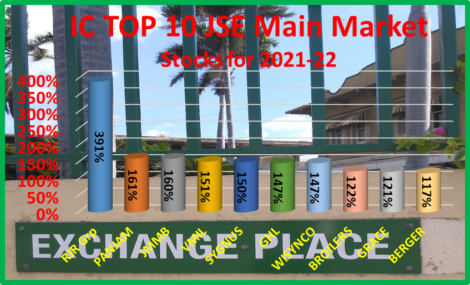 Scotia Group, along with Caribbean Cream, fell out of the TOP10 based on downward revisions to their earnings for the coming financial year ends. Moving into the Junior Market TOP10 is ISP Finance with the price dropping to $15.60 on Friday and the Main Market listed, Berger Paints moving back in the TOP10 with the price at $13.85 on Friday.
Scotia Group, along with Caribbean Cream, fell out of the TOP10 based on downward revisions to their earnings for the coming financial year ends. Moving into the Junior Market TOP10 is ISP Finance with the price dropping to $15.60 on Friday and the Main Market listed, Berger Paints moving back in the TOP10 with the price at $13.85 on Friday.
JMMB Group came outwith solid results for the full year to March, leading to a revision of the projection for the 2022 fiscal year, making the stock a solid buy even after it rose 12 percent to $38.45 from $32.50 last week, Grace Kennedy jumped 5 percent from $94.97 last week to close at $99.46, PanJam Investment moved up 11 percent from $54.50 to $69 and Future Energy Sources closed the week at a 52 weeks’ high of $1.10, to be marginally up for the week from $1.07.
 The average gains projected for the Junior Market slipped from 210 percent last week to 207 percent as the market slowly rises. The average projected gains for the Main Market stocks dropped last week from 170 to 166 percent as the market gained 3 percent for the week.
The average gains projected for the Junior Market slipped from 210 percent last week to 207 percent as the market slowly rises. The average projected gains for the Main Market stocks dropped last week from 170 to 166 percent as the market gained 3 percent for the week.
The top three stocks in the Junior Market continue to be Elite Diagnostic heading the list, followed by Medical Disposables and Caribbean Assurance Brokers, with the potential to gain between 247 to 300 percent. The top three Main Market stocks are Radio Jamaica in the number one spot, followed by PanJam Investments and JMMB Group, with expected gains of 160 to 391 percent.
 The targeted PE ratio for the market remains an average of 20 based on profits of companies reporting full year’s results up to the second quarter of 2022. Fiscal 2020-21 ended March 2021 with the average PE at 17 for Junior Stocks and 19 times for the Main Market. One reason why the Junior Market stocks have outperformed Main Market ones since last year can be seen from the big difference between the valuations of both markets, with the latter values close to maturity, based on present valuation metrics.
The targeted PE ratio for the market remains an average of 20 based on profits of companies reporting full year’s results up to the second quarter of 2022. Fiscal 2020-21 ended March 2021 with the average PE at 17 for Junior Stocks and 19 times for the Main Market. One reason why the Junior Market stocks have outperformed Main Market ones since last year can be seen from the big difference between the valuations of both markets, with the latter values close to maturity, based on present valuation metrics.
The Junior Market, with an average PE 13 based on ICInsider.com’s 2021-22 earnings, is currently trading well below the target, as well as the recent historical average of 17, for the market to get to last year average, would require a 32 percent rise in the market, that would equate to a rise of 54 percent to March 2022 if it were to reach the targeted PE of 20. 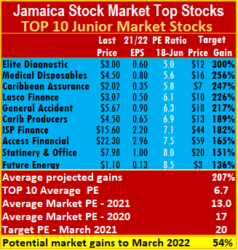 The Junior Market Top 10 stocks average a mere 6.7 at just 51 percent of the market average, indicating substantial gains ahead. The JSE Main Market ended the week with an overall PE of 17.1, a little distance from the 19 the market ended in March, suggesting just an 11 percent rise at a PE of 19 and 17 percent at a PE of 20 from now to March 2022. The Main Market TOP 10 trades at a PE of 7.9 or 46 percent of the PE of that market, well off the potential of 20.
The Junior Market Top 10 stocks average a mere 6.7 at just 51 percent of the market average, indicating substantial gains ahead. The JSE Main Market ended the week with an overall PE of 17.1, a little distance from the 19 the market ended in March, suggesting just an 11 percent rise at a PE of 19 and 17 percent at a PE of 20 from now to March 2022. The Main Market TOP 10 trades at a PE of 7.9 or 46 percent of the PE of that market, well off the potential of 20.
IC TOP10 stocks are likely to deliver the best returns up to March 2022 and ranked in order of potential gains, based on likely increase for each company, taking into account the earnings and PE ratios for the current fiscal year. Expected values will change as stock prices fluctuate and result in movements in and out of the lists weekly. Revisions to earnings per share are ongoing, based on receipt of new information.
Persons who compiled this report may have an interest in securities commented on in this report.

 The “joint venture is in line with CAC 2000 strategy to develop complementary partnerships which are in keeping CAC’s purpose of Improving People’s Lives by excelling as the leading experts on energy and Indoor Environmental Quality, by engineering solutions and providing products and services that sustain healthy, comfortable and productive indoor environments, actively generating energy savings for our customers, whilst improving and diversifying our revenue streams, the release goes on to states. Tropical Battery has over 70 years of experience in the energy storage business.
The “joint venture is in line with CAC 2000 strategy to develop complementary partnerships which are in keeping CAC’s purpose of Improving People’s Lives by excelling as the leading experts on energy and Indoor Environmental Quality, by engineering solutions and providing products and services that sustain healthy, comfortable and productive indoor environments, actively generating energy savings for our customers, whilst improving and diversifying our revenue streams, the release goes on to states. Tropical Battery has over 70 years of experience in the energy storage business. Trading ended with five securities changing hands, compared to eight on Tuesday with the prices of one stock rising, two declining and two remaining unchanged.
Trading ended with five securities changing hands, compared to eight on Tuesday with the prices of one stock rising, two declining and two remaining unchanged.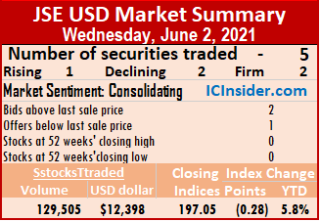 At the close, First Rock Capital had an exchange of 44,814 shares at 8.99 US cents, Productive Business Solutions had trading of 9 stock units at 80 US cents, Proven Investments lost 0.1 of a cent to end at 25.9 US cents with 21,708 units changing hands. Sterling Investments slipped 0.01 of a cent to 2 US cents with a transfer of 52,000 stocks and Sygnus Credit Investments rose 0.48 of a cent to close at 15.49 US cents with 10,974 shares crossing the exchange.
At the close, First Rock Capital had an exchange of 44,814 shares at 8.99 US cents, Productive Business Solutions had trading of 9 stock units at 80 US cents, Proven Investments lost 0.1 of a cent to end at 25.9 US cents with 21,708 units changing hands. Sterling Investments slipped 0.01 of a cent to 2 US cents with a transfer of 52,000 stocks and Sygnus Credit Investments rose 0.48 of a cent to close at 15.49 US cents with 10,974 shares crossing the exchange. Ackee one of the best loved food items in Jamaica had a mere 3 percent rise in 2020 over 2017 but has fallen 25 percent in 2018 versus 2017, it grew 27 percent in 2019 and 7 percent in 2020. Other Food Exports grew 33 percent between 2017 and 2020 to reach US$33 million after rising 23 percent in 2020 over 2019. Meat & Meat Preparations export segment is not large in monetary terms with just US$9.4 million in export earnings in 2020 but it grew 38 percent over the four year period, since 2017, with an 11 percent increase, 15 in 2019 and 8 percent in 2020 over 2019.
Ackee one of the best loved food items in Jamaica had a mere 3 percent rise in 2020 over 2017 but has fallen 25 percent in 2018 versus 2017, it grew 27 percent in 2019 and 7 percent in 2020. Other Food Exports grew 33 percent between 2017 and 2020 to reach US$33 million after rising 23 percent in 2020 over 2019. Meat & Meat Preparations export segment is not large in monetary terms with just US$9.4 million in export earnings in 2020 but it grew 38 percent over the four year period, since 2017, with an 11 percent increase, 15 in 2019 and 8 percent in 2020 over 2019. Elsewhere, the 2021 TOP 15 listed Carreras that migrated from the 2021 ICTOP10 in February hit a new 52 weeks’ high during the week to sit at $10 for a rise of 45 percent for the year to date. The price could climb further, helped by improving profit and a high dividend yield. Future Energy Source (Fesco) hangs onto the Junior Market TOP10 list at the tenth position, with the prospectus still to be released to the public.
Elsewhere, the 2021 TOP 15 listed Carreras that migrated from the 2021 ICTOP10 in February hit a new 52 weeks’ high during the week to sit at $10 for a rise of 45 percent for the year to date. The price could climb further, helped by improving profit and a high dividend yield. Future Energy Source (Fesco) hangs onto the Junior Market TOP10 list at the tenth position, with the prospectus still to be released to the public.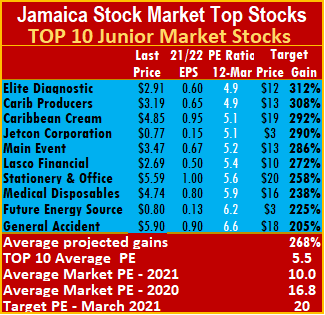
 The Junior Market TOP10 contains companies that suffered a sharp reversal of revenues and profit in 2020, with recovery projected for them in 2021. Green shoots are showing for some, with sales picking up in recent quarters with improving bottom-line. Some of these companies may require another quarter or two of improving fortunes before there is meaningful buying into them. The Main Market has a number in the list that has put out record profits or shows strong earnings in 2021, with the stocks clearly undervalued. These include JMMB Group, Jamaica Broilers, Sygnus Credit Investments and Grace Kennedy that are currently in the TOP10 Main Market listing and Caribbean Cement that is just outside.
The Junior Market TOP10 contains companies that suffered a sharp reversal of revenues and profit in 2020, with recovery projected for them in 2021. Green shoots are showing for some, with sales picking up in recent quarters with improving bottom-line. Some of these companies may require another quarter or two of improving fortunes before there is meaningful buying into them. The Main Market has a number in the list that has put out record profits or shows strong earnings in 2021, with the stocks clearly undervalued. These include JMMB Group, Jamaica Broilers, Sygnus Credit Investments and Grace Kennedy that are currently in the TOP10 Main Market listing and Caribbean Cement that is just outside.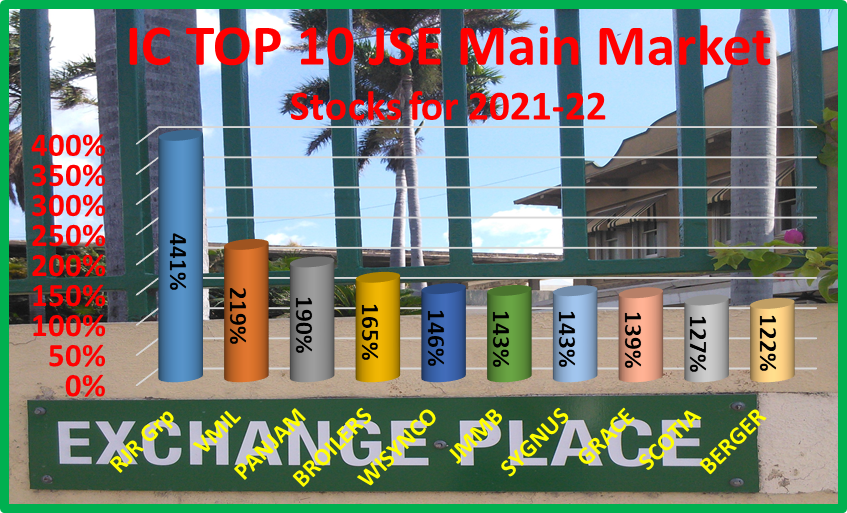 The top three stocks in the Junior Market with the potential to gain between 292 to 312 percent are Elite Diagnostic, followed by Caribbean Producers and Caribbean Cream. With expected gains of 190 to 441 percent, the top three Main Market stocks are Radio Jamaica, followed by VM Investments and PanJam Investment.
The top three stocks in the Junior Market with the potential to gain between 292 to 312 percent are Elite Diagnostic, followed by Caribbean Producers and Caribbean Cream. With expected gains of 190 to 441 percent, the top three Main Market stocks are Radio Jamaica, followed by VM Investments and PanJam Investment.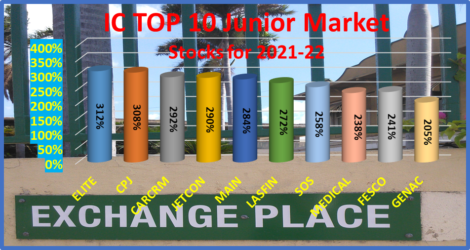 The Main Market TOP 10 stocks trade at a PE of 7.5 or 50 percent of that market’s PE.
The Main Market TOP 10 stocks trade at a PE of 7.5 or 50 percent of that market’s PE. The preliminary results showed that 37 percent of the electorate voted, down from around 50 percent in 2016, when the voters’ list was purged of deceased persons. That is a colossal decline. Although the
The preliminary results showed that 37 percent of the electorate voted, down from around 50 percent in 2016, when the voters’ list was purged of deceased persons. That is a colossal decline. Although the  When applied against the
When applied against the 





 That is not far from the February polls done by
That is not far from the February polls done by 




